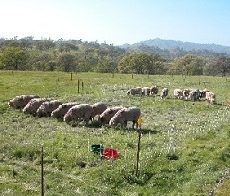Oaks ’n’ Folks – Volume 12, Issue 2 – September, 1997
Hardwood rangelands comprise approximately nine million acres- just under 10% of the total land area-in California. In contrast to higher elevation coniferous forests which are often publicly owned, about 80% of the hardwood rangelands in the state are in private ownership. Since European settlement, the primary agricultural use of these lands has been livestock grazing. The economic rent for this activity is relatively low, in the neighborhood of $8 to $15 per acre per year. This low rate of return, and fluctuations in meat and wool prices, have resulted in difficult economic times for some ranchers, causing the reduction or loss of equity and ultimately the conversion of some rangelands to residential use.
Simultaneously growing trees on these grazing lands has been suggested as a possible means of increasing revenue by providing landowners with an annual income from livestock while the trees are maturing. Though forest grazing is common in California, establishing plantations where trees and livestock are raised together on rangelands has not been seriously tested in the state. However, such systems have been extensively and successfully used in New Zealand, Australia, and elsewhere, primarily with Monterey pine plantations and sheep grazing.
The most common trees on typical hardwood rangelands in California are native oaks. While these species are tremendously important for wildlife and aesthetics, and there is widespread interest in oak conservation, they generally grow slowly and have little economic value, other than for firewood.As such, they are poor candidates for use in an agroforestry system. While the importance of maintaining existing stands of native oaks is well recognized,there are vast areas in the state where trees have either not become established,or have been previously removed. Small plots of these cleared grazing lands may be suitable for planting one or more species of conifers, which can tolerate relatively harsh rangeland conditions, yet grow much more rapidly than oaks. Tree crops could be used for a variety of products including pulp, lumber, biomass, Christmas trees or firewood. If successful, such plantations could actually promote oak conservation by reducing the demand for oak firewood, and providing landowners with more income, thus reducing the pressure to sell and subdivide. However, it is not clear which conifers will perform well in these environments and whether or not livestock can simultaneously graze these lands without damaging trees.
To evaluate the potential of four pine taxa (Monterey pine, knob cone pine, a hybrid between these two species called KMX, and Coulter pine) to grow on low elevation hardwood rangelands, a study was initiated at the Sierra Foothill Research and Extension Center in 1991. Two hundred forty,one-year-old seedlings from each of the four taxa were planted on a 10-foot spacing, within a cattle exclosure. Four treatments were evaluated: augering to a depth of 2 feet and placement of a 21 gram fertilizer tablet; 2) augering,but no fertilization; 3) fertilization, but no augering; 4) no augering and no fertilization.
After two years, approximately 10 head of cattle were placed in the plot each spring for several weeks. Immediately after each of these grazing intervals,we assessed each of the trees for evidence of injury from the cattle. Year-end height and survival of each surviving tree were also measured every year.
Results to date indicate that several pine taxa can survive and grow-at least initially-on unirrigated hardwood rangelands in California. After six years, most trees were well over 10 feet tall. Once the trees have become established and are 2-3 feet tall, the pastures they are planted in can also be grazed by cattle without substantial damage to the trees. Augering 2-foot deep holes prior to planting appeared to offer no positive benefit.Fertilization, on the other hand, improved height growth by about 10%.
Agroforestry systems using pines and cattle show promise on California’soak woodlands, especially for Monterey and KMX pines. However, more time is needed to evaluate the long-term survival and growth rates in these environments,and to determine if the potential benefits of such systems outweigh the risks of droughts, freezes, or diseases such as pitch canker.
Douglas McCreary
prepared and edited by Richard B. Standiford and Pamela Tinnin

